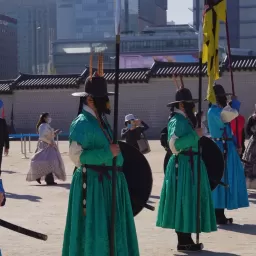Cultural Heritage
Korea is home to a wealth of cultural heritage sites that reflect its rich history and traditions
 Bonus: Korean Culture:
Korean culture is a blend of tradition and modernity, preserving its heritage while embracing contemporary influences. Let’s learn more about it.
Bonus: Korean Culture:
Korean culture is a blend of tradition and modernity, preserving its heritage while embracing contemporary influences. Let’s learn more about it.
Korea is home to a wealth of cultural heritage sites that reflect its rich history and traditions. Here are some details about the cultural heritage of Korea:
-
UNESCO World Heritage Sites:
-
Changdeokgung Palace Complex: Located in Seoul, this palace complex is a UNESCO World Heritage Site. It is renowned for its harmonious integration with the natural landscape, including gardens, pavilions, and a beautiful rear garden called Huwon.
-
Gyeongbokgung Palace: Another UNESCO-listed palace, Gyeongbokgung, is the largest of the Five Grand Palaces built during the Joseon Dynasty. It is an iconic symbol of Korea’s royal history and features impressive architecture, including Geunjeongjeon (the main throne hall) and Gyeonghoeru (a pavilion surrounded by water).
-
Seokguram Grotto and Bulguksa Temple: Located in Gyeongju, these sites are UNESCO World Heritage Sites. Seokguram houses a monumental Buddha statue, while Bulguksa Temple is considered a masterpiece of Buddhist architecture from the Silla Dynasty.
-
Hwaseong Fortress: Situated in Suwon, Hwaseong Fortress is a UNESCO site known for its innovative defensive features, including the use of floodgates and observation towers. It is a prime example of late 18th-century military architecture.
-
-
Historic Palaces:
-
Gyeongbokgung Palace: As mentioned earlier, Gyeongbokgung is the largest and most iconic of the Five Grand Palaces in Seoul. It served as the main royal palace during the Joseon Dynasty and is a symbol of Korean sovereignty.
-
Changdeokgung Palace: Known for its beautiful architecture and scenic gardens, Changdeokgung served as a secondary palace to Gyeongbokgung. It is notable for its integration with nature and its historical significance.
-
Changgyeonggung Palace: This palace, adjacent to Changdeokgung, has a more serene and natural atmosphere. It was originally built as a residence for queens and concubines.
-
-
Buddhist Temples:
-
Bulguksa Temple: Located near Gyeongju, Bulguksa is one of the most famous Buddhist temples in Korea. Its intricate architecture and beautiful surroundings make it a significant cultural and religious site.
-
Bongeunsa Temple: Situated in Seoul, Bongeunsa is a serene Buddhist temple in the midst of the bustling city. It offers a peaceful retreat and features cultural artifacts, including a massive statue of Buddha.
-
-
Preserved Cultural Traditions:
-
Hanbok: The traditional Korean clothing, known as Hanbok, is still worn on special occasions and ceremonies. It reflects the elegance and beauty of Korean culture, with distinct styles for men and women.
-
Jeonju Hanok Village: Located in Jeonju, this village is known for its well-preserved traditional Korean houses (hanoks). It provides visitors with a glimpse into the lifestyle of the past.
-
Ceremonial Rituals: Traditional Korean ceremonies, such as the Confucian-based Coming-of-Age Ceremony (Gwallye), are still observed, highlighting the importance of cultural continuity.
-
Korea’s cultural heritage sites and traditions play a crucial role in preserving and showcasing the country’s history, artistic achievements, and spiritual practices. Visitors to Korea often find these sites to be a fascinating blend of ancient traditions and modern vibrancy.